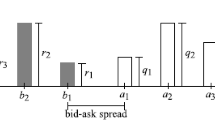Abstract
We consider a financial market model with a single risky asset whose price process evolves according to a general jump-diffusion with locally bounded coefficients and where market participants have only access to a partial information flow. For any utility function, we prove that the partial information financial market is locally viable, in the sense that the optimal portfolio problem has a solution up to a stopping time, if and only if the (normalised) marginal utility of the terminal wealth generates a partial information equivalent martingale measure (PIEMM). This equivalence result is proved in a constructive way by relying on maximum principles for stochastic control problems under partial information. We then characterize a global notion of market viability in terms of partial information local martingale deflators (PILMDs). We illustrate our results by means of a simple example.
Similar content being viewed by others
References
Aase K, Øksendal B, Privault N, Ubøe J (2000) White noise generalizations of the Clark-Haussmann-Ocone theorem, with application to mathematical finance. Finance Stochast 4:465–496
Baghery F, Øksendal B (2007) A maximum principle for stochastic control with partial information. Stoch Anal Appl 25:705–717
Barucci E (2003) Financial markets theory: equilibrium, efficiency and information. Springer, London
Björk T, Davis M, Landen C (2010) Optimal investment under partial information. Math Methods Oper Res 71:371–399
Choulli T, Deng J, Ma J (2012) The fundamental theorem of utility maximization and numéraire portfolio. Preprint, available at: arXiv:1211.4598
Delbaen F, Schachermayer W (1994) A general version of the fundamental theorem of asset pricing. Math Ann 300:463–520
Delbaen F, Schachermayer W (1995) Arbitrage possibilities in Bessel processes and their relations to local martingales. Probab Theory Relat Fields 102:357–366
Delbaen F, Schachermayer W (1998) The fundamental theorem of asset pricing for unbounded stochastic processes. Math Ann 312:215–250
Di Nunno G, Øksendal B, Proske F (2009) Malliavin calculus for Lévy processes with applications to finance. Springer, Berlin - Heidelberg
Elworthy KD, Li XM, Yor M (1999) The importance of strictly local martingales; applications to radial Ornstein-Uhlenbeck processes. Probab Theory Relat Fields 115:325–355
Fontana C, Runggaldier WJ (2013) Diffusion-based models for financial markets without martingale measures. In: Biagini F, Richter A, Schlesinger H (eds) Risk measures and attitudes, EAA series. Springer, London, pp 45–81
Frittelli M (2004) Some remarks on arbitrage and preferences in securities market models. Math Financ 14:351–357
Harrison JM, Kreps D (1979) Martingales and arbitrage in multiperiod securities markets. J Econ Theory 20:381–408
He S, Wang J, Yan J (1992) Semimartingale theory and stochastic calculus. CRC Press, Hong Kong
Hu Y, Imkeller P, Müller M (2005) Utility maximization in incomplete markets. Ann Appl Probab 15:1691–1712
Jacod J, Shiryaev AN (2003) Limit theorems for stochastic processes, 2nd edn. Springer, Berlin - Heidelberg
Karatzas I, Kardaras C (2007) The numéraire portfolio in semimartingale financial models. Finance Stochast 11:447–493
Kardaras C (2012) Market viability via absence of arbitrage of the first kind. Finance Stochast 16:651–667
Korn R, Oertel F, Schäl M (2003) The numeraire portfolio in financial markets modeled by a multi-dimensional jump diffusion process. Decisions Econ Finan 26:153–166
Kramkov D, Schachermayer W (1999) The asymptotic elasticity of utility functions and optimal investment in incomplete markets. Ann Appl Probab 9(3):904–950
Kreps D (1981) Arbitrage and equilibrium in economies with infinitely many commodities. J Math Econ 8:15–35
Lakner P (1995) Utility maximization with partial information. Stoch Process Appl 56:247–273
Lakner P (1998) Optimal trading strategy for an investor: the case of partial information. Stoch Process Appl 76:77–97
Loewenstein M, Willard G (2000) Local martingales, arbitrage and viability. Economic Theory 16:135–161
Morlais MA (2009) Utility maximization in a jump market model. Stochastics 81:1–27
Øksendal B, Sulem A (2007) Applied stochastic control of jump diffusions, 2nd edn. Springer, Berlin - Heidelberg - New York
Øksendal B, Sulem A (2012) Forward-backward stochastic differential games and stochastic control under model uncertainty. J Optim Theory Appl. doi:10.1007/s10957-012-0166-7
Pascucci A, Runggaldier WJ (2012) Financial mathematics: theory and problems for multi-period models. Springer, Milan
Pliska S (1997) Introduction to mathematical finance. Blackwell, Oxford
Rasony M, Stettner L (2005) On utility maximization in discrete-time financial market models. Ann Appl Probab 15(2):1367–1395
Revuz D, Yor M (1999) Continuous Martingales and Brownian motion. Springer, Berlin - Heidelberg - New York
Runggaldier WJ (2003) Jump-diffusion models. In: Rachev ST (ed) Handbook of heavy tailed distributions in finance. Elsevier - North Holland, Amsterdam, pp 169–209
Schachermayer W (2001) Optimal investment in incomplete markets when wealth may become negative. Ann Appl Probab 11(3):694–734
Schäl M (2000a) Price systems constructed by optimal dynamic portfolios. Math Methods Oper Res 51:375–397
Schäl M (2000b) Portfolio optimization and martingale measures. Math Financ 10(2):289–303
Stettner L (2012) Asymptotics of utility from terminal wealth for partially observed portfolios. Applicationes Math 39:445–461
Stricker C (1977) Quasimartingales, martingales locales, semimartingales et filtration naturelle. Z Wahrscheinlichkeit 39:55–63
Xing H (2012) On backward stochastic differential equations and strict local martingales. Stoch Process Appl 122:2265–2291
Author information
Authors and Affiliations
Corresponding author
Rights and permissions
About this article
Cite this article
Fontana, C., Øksendal, B. & Sulem, A. Market Viability and Martingale Measures under Partial Information. Methodol Comput Appl Probab 17, 15–39 (2015). https://doi.org/10.1007/s11009-014-9397-4
Received:
Revised:
Accepted:
Published:
Issue Date:
DOI: https://doi.org/10.1007/s11009-014-9397-4
Keywords
- Optimal portfolio
- Jump-diffusion
- Partial information
- Maximum principle
- BSDE
- Viability
- Utility maximization
- Martingale measure
- Martingale deflator




